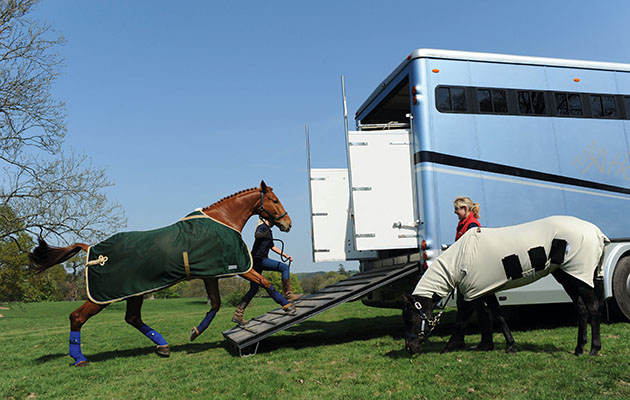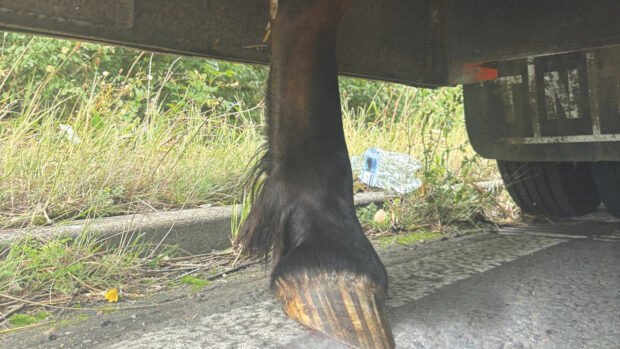Jason Webb of Australian Horse Training is a renowned UK-based horse trainer with a passion for starting young horses, solving equine problems and teaching riders of all abilities and ambitions develop and strengthen the partnership they have with their horses. Here Jason helps one H&H forum user with a horse who sometimes stands on the tack locker in the horsebox
Q: Rearing in lorry and getting stuck on tack locker: “I have a very bad tempered and argumentative warmblood. This morning we were leaving for a show and I stopped for five minutes halfway down the drive to just run in the house. He could see his two mates in the field and went bananas, striking out, which he often does when he’s angry. He also does it in the stable when he’s left alone. He then reared up and got stuck up on the tack locker. I don’t know whether he meant to get up there or if he just struck out high and then found himself up there. He was literally tap dancing on the ceiling and pommelling the hell out of the wall. I had to get in there and try and bend his legs to get him down — it was all quite terrifying! He was up there for quite some time too. Does anyone have any suggestions on this as really don’t want to play that game again. He did it at a show once when his friend went out of sight. He was on his own in there today. Someone at the show said if it is anger, I should hobble him but if it’s panic don’t as he’ll kill himself? I’m not mad keen on hobbles to be honest. Any ideas would be great.”
A: “Hi,
“It sounds like you have your hands full with your horse! Your description of him being “argumentative and bad tempered” may mean that you have to do plenty of work on his groundwork to establish you as the one in charge and to change his behaviour when being handled. It would be interesting to know what he is like to ride.
“The problem that you have described doesn’t sound like a travelling problem, but more like an attachment issue exacerbated by being on a lorry. Your first port of call should be to address the attachment issue first, as this is the root cause.
Continued below…
Related articles:
“I do a tying up exercise called “standing on the tie”, which would be a really useful thing to do with him. It involves tying your horse safely on the yard (I use a resistance tie system) before moving your horse’s hindquarters over from right to left and back a few times, before asking them to stand and settle at a point of your choosing, through your body language and saying the word “stand” as his cue. Then, walk at a safe distance behind them to see if they stay standing. If they move off the spot, repeat the exercise until they stand without moving. This can take a lot of patience and repetition, but it is an important step in training your horse.
“If you can get him good at this exercise, whenever he gets fractious, you can take his mind of other horses, refocus him and show him where to stand to be comfortable and relaxed, by your body language and the use of the cue word, “stand”. It is also the start of establishing his respect for you; he moves and stands when you ask him to, not when he feels like it. This exercise can be seen on www.yourhorsemanship.com. I would practice this in as many different environments as possible, including when he is tied to a lorry.
“I would also use a bit of reverse psychology for developing his tolerance to being on the horsebox. When he starts kicking up a fuss and wanting to get off, allow him to do so. But as soon as he is off, turn him sharply back round and put him straight back on again. Or, if he is full of energy, lunge him in a few circles before reloading him. When he is back on the lorry, let him relax, give him a rub, and if he stands quietly where you want him to, give him a “treat” (but please make sure that is the only time you do give him any food during this process!). With repetition, he will begin to realise that when he comes off the box he has to work, and when he is on the box, he is left to stand and relax; therefore the box becomes a good place to be.
“As with most areas of horse training, there is no quick, easy fix, so you need to be prepared to put in as much work on the ground as with his ridden work to get him manageable. Lastly, you mentioned hobbles in your letter. Hobbles are used as a restraint, and horses have to be carefully trained to accept them. Growing up in rural Australia, hobbles were still used in certain situations, but you rarely see them in use now in the UK. I would steer well clear of them as I think you could end up with more problems than you started with, and you would not be addressing the root cause of the problem. Please feel free to get in touch if you need more help.”
For more information on Jason Webb and his online training base Your Horsemanship, where you can learn a foundation in horse training with online lessons in groundwork, starting, and ridden fundamentals, visit his website




